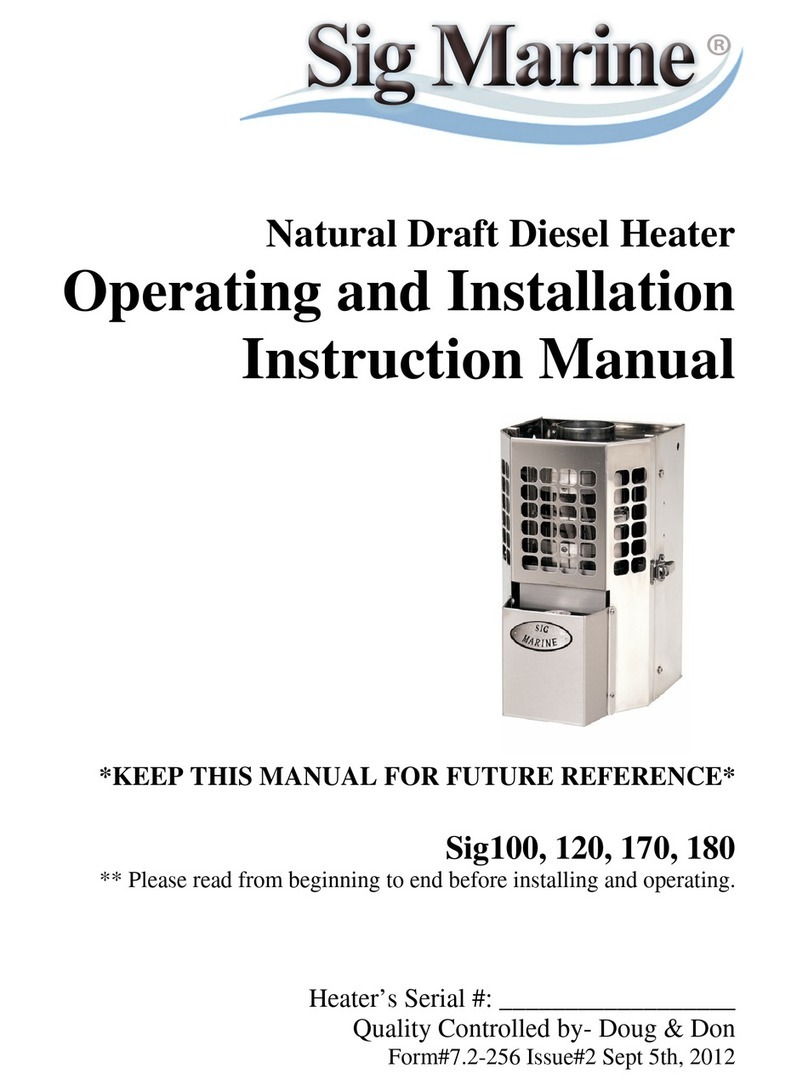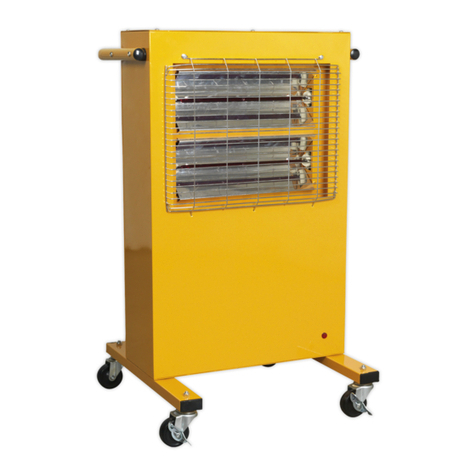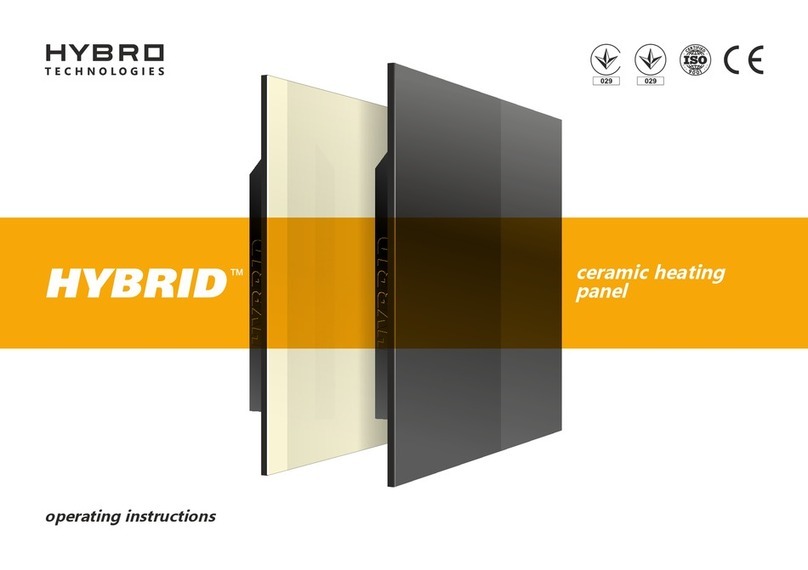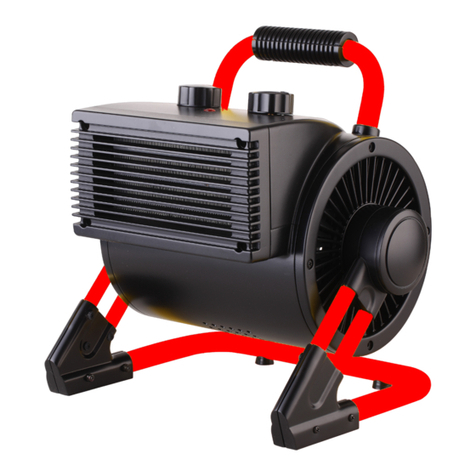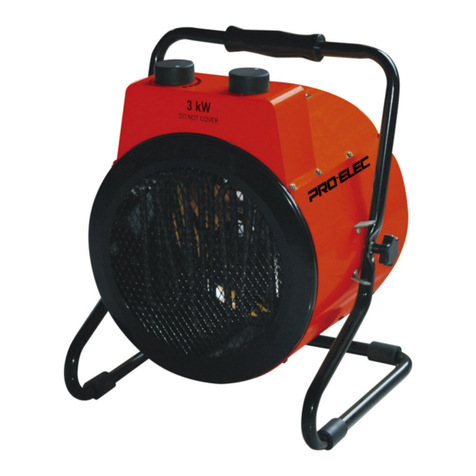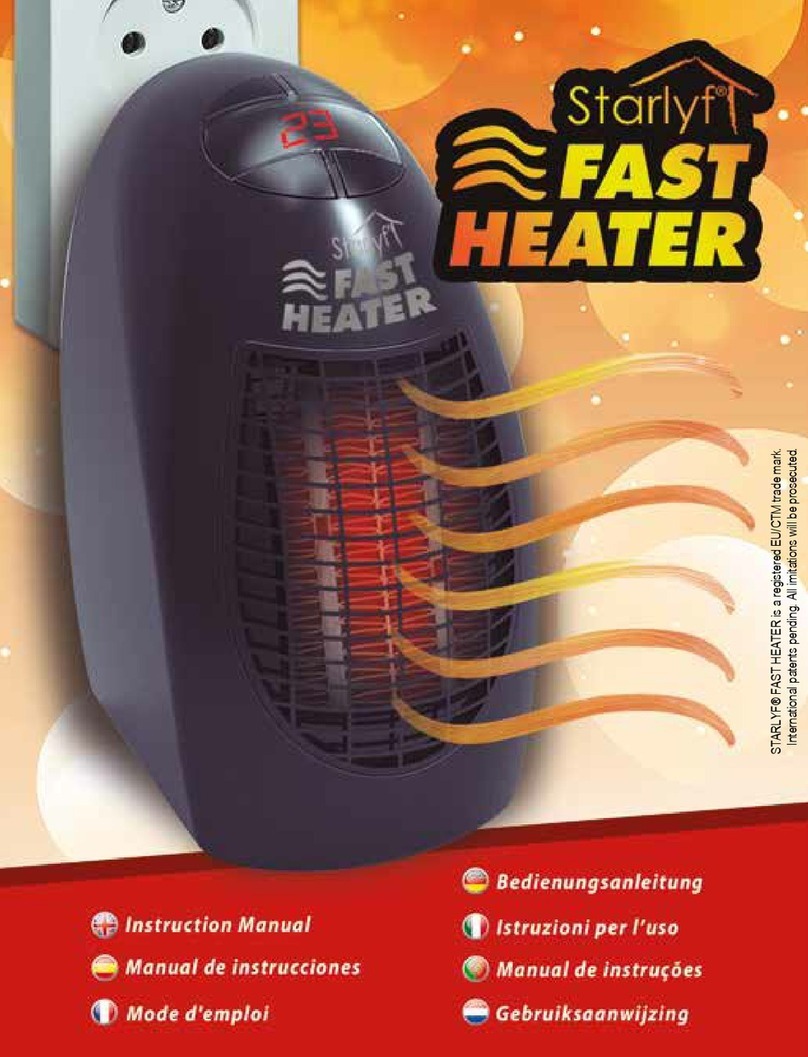Sig Marine 100 User manual

Sig Marine Products
#407-204 Cayer St. Coquitlam
B.C. Canada V3K 5B1
www.sigmarine.com
info@sigmarine.com
T: 800 659 9768
Stoves /Heaters
Instruction Manual
MODELS
100, 120, 170, 180 HEATERS & 200 , 250 STOVES
This manual must be read and the requirements carried out
to ensure satisfactory performance.
SIG MARINE RESERVES THE RIGHT TO MAKE CHANGES TO PRODUCTS
OR DOCUMENTS AT ANY TIME
QUALITY INSPECTED BY- Doug & Don DATE- Nov 5/2008

-1-
CONTENTS
Warnings and Disclosures pg-2 Burner Assembly pg-20
Installation Diagrams pg-3 Burner Diagram pg-21
Clearance Diagram pg-4 Air & Balanced Draft pg-21
Location pg-4 Draft Assist Fan pg-22
Mounting and Securing pg-5 Checklist pg-23
Flue Stack (chimney) pg-6 Lighting Instructions pg-24
Barometric Install pg-6 Operating tips pg-26
Deck Fittings pg-7 Flooding Burner pg-27
Fuel Supply pg-8 Water Exchanger pg-27
Fuel Pump Install pg-8 Exchanger Install pg-28
Pump Diagrams pg-10 Burner Cleaning pg-29
Fuel Overflow pg-12 Casting Maintenance pg-31
Fuel Diagram pg-13 Trouble Shooting pg-32
Fuel Variations pg-13 FAQ pg-33
Fuel Measurement &Adjustment pg-14 Limited Warranty pg-34
Valve Info pg-15 Warranty Form pg-35
Valve Rebuild pg-16
Fuel Consumption pg-17
Valve Diagram pg-19
Valve Safety Features pg-20

-2-
Warnings and Disclosures
- Follow all installation and operating procedures.
- The oil heater/stove requires an installed flue for correct operation.
Do not attempt to operate the heater/stove without the flue chimney installed
correctly as required in this manual.
- A permanently open fresh air inlet vent must be installed near the heater/
stove to provide air for the combustion or balance draft system installed.
- The fuel supply must have a manual shut-off at the fuel tank as well as a
manual shut-off near the heater/stove.
- The fuel must be filtered to at least 10 microns and not exceed 4 PSI of
pressure.
- The fuel type stamped on the side of the oil metering valve is the same as
the fuel in the tank. D-diesel, SO- stove oil or #1 diesel , K-kerosene
- A barometric damper installed and adjusted is a must for good draft and
complete combustion.
- Do not use substitute valves, burners, or fan motors
- Keep the flames burning completely above the top burner ring after heater
is warmed up.
- Turn off the heater/stove when refueling.
-DO NOT OPERATE THIS HEATER/STOVE UNATTENDED !

-3-
Installation Diagram
NOTE: Not all installations will require balanced draft, a pump, gravity tank, or elbows.

-3B-

-4-
Clearance Diagram
Installation Guidelines
Location
The location of the heater/stove must be large enough to provide safety clearances.
Objects and materials closer to the heater than 6” must be lined with high density, heat
retardant insulation and covered with metal (stainless steel, aluminum, etc.). Another
alternative is using ceramic tiles. Particular care must be taken to protect the surfaces
close to the first section of flue pipe.
The install location should also take into account the length and configuration of the flue
stack. It is generally preferable that the flue stack be a long straight run. If you have the
option, avoid having to use elbows. Consider installing a balanced draft see pg-21.

-5-
Ideally, the heater/stove should face the bow or stern of the vessel, particularly on a
sailboat. Fuel gravity feeds from the oil-metering valve into the burner. Should this valve
drop below the level of the burner, fuel will not flow uphill into the burner and the fire
will go out. In a beam-facing sailboat installation, the oil metering valve may have to be
relocated to the side of the heater. There are holes on the side to hold the repositioned
valve bracket. If you have any doubt regarding the need for a valve bracket, please ask
your dealer or email info@sigmarine.com
Mounting and Securing
Model 180 heater holes have been provided in the feet to allow appropriate fasteners to
secure. The drip tray will then slide under the bottom of the heater.
Model 200 & 250 unscrew the acorn nuts on the front bottom panel. Unclip the speed
control wires. Secure the tie-down bar (supplied) to the floor 2 ins from the back of the
area where the stove will sit. The raised ends of the bar must be up, to allow the side
flanges (“feet”) of your stove to slide underneath. This will allow the stove to be slid
forward for service and cleaning while also securing it firmly to the boat.
The stove must be leveled and secured at the front through the bolt holes at the base of
the side panels. Use the fastener appropriate for the material of the floor where the stove
is to be secured. The finishing tray (supplied) will slide under the stove.
Model 100 to 170 use appropriate hardware to secure the heater to insulated area.

-6-
Flue Stack
The length and straightness of the flue stack are important to the efficient operation of the
heater/stove. The Flue stack must be the correct diameter. If elbows must be used, the
elbows shall not be greater than a 45 degree angle. The first elbow should not be closer
than 12” (28cm) to the heater/stove. Allow for as much straight pipe as possible before
the first elbow. The stove pipe will attach to the stove by squeezing the round pipe
over the oval flue collar when installing.
A Barometric Damper is a MUST FOR BEST COMBUSTION.
The barometric damper should be installed in oil and solid fuel heaters and stoves. The
purpose is to maintain a strong draft without causing too much air to the fuel mixture.
When the damper is adjusted the draft is altered by allowing air to be pulled into the
chimney by the air inlet on the damper and not pulled into the primary mixing holes in
the burner.
Install the barometric tee pipe with the front flap facing fore and aft.
In order for the barometric to work efficiently it must be installed between 12” and 24”
from the heater/stove exhaust collar. If using a pipe guard turn the barometric tee to the
back as it does not have to be seen to work.
To adjust the flap on the barometric back off the jam nut and turn the counterweight so
the flap is standing closed. The valve must be set to flow 1 teaspoon per the amount of
seconds as per the list of fuel flow measurements on page 12, and on the #1 lowest
setting. Once the heater/stove has been burning for some time and the room temperature
is starting to rise is a good time to do the adjustment.
Adjust the counterweight so the flap starts to open (aprox 6mm or ¼”). This will allow air
to enter the barometric tee and reduce the air entering the burner. This will cause the
flame to burn above the top burner ring. If the flame is still burning below the ring adjust
the flap open another 3mm or 1/8”. At this time if there is flame burning below the top
burner ring and the barometric flap is open aprox 9mm or 3/8” do not adjust the flap open
any further and re-adjust the valve fuel flow rate until the flame is above the ring.
This adjustment need only done once after the install and the jam nut can be re-tightened.
The draft above the top of the fire will be aprox -.05 inches of water column, should you
have a draft meter, however adjusting the damper as above should get you close enough.

-7-
Sig Marine can supply you with a stainless steel thru-deck fitting for your pipe
installation. The thru-deck fitting includes a stainless steel dress ring for the interior of
the cabin and a rubber (neoprene) gasket easy mounting. Depending on the contour or the
angle of the cabin top, you may need to make a hardwood spacer block. One surface of
the block would be a level plane to mate to the deck cap. The other would match the
angle or contour of the cabin top. A hole through the center of the block would be 2
inches greater in diameter than the flue pipe.
Flue Diameter Recommended
Length
Minimum Length Hole Diameter
Sig 100 3” (7.62cm) 6 ft (1.83m) 3 ft (0.92M) 5” (12.7cm)
Sig 120 3” (7.62cm) 6 ft (1.83m) 3 ft (0.92M) 5” (12.7cm)
Sig 170 3” (7.62cm) 6 ft (1.83m) 4 ft (1.23m) 5” (12.7cm)
Sig 180 3” (7.62cm) 6 ft (1.83m) 4 ft (1.23m) 5” (12.7cm)
Sig 200
4” Standard (10.16cm)
5” Optional (12.7cm)
6 ft (1.83m) 4 ft (1.23m) 6” (10.16cm) Standard
7” (17.78cm) Optional
Sig 250
4” Standard (10.16cm)
5” Optional (12.7cm)
6 ft (1.83m) 4 ft (1.23m) 6” (10.16cm) Standard
7” (17.78cm) Optional

-8-
The H style flue caps are recommended, especially if the balanced draft system is not
used. The location of the flue cap above deck must be clear of any immediate obstruction
that may cause unusual air movement or turbulence. CAUTION : The Flue Cap gets hot
when the stove is operating.
Note: The caps, pipe, and deck fitting may appear to have a rusting look. This is caused
by operating the heater too rich. This will produce soot that will leave carbon deposits on
the stainless steel giving the appearance of rust, much like cleaning stainless steel with a
steel SOS pad. The stainless can be cleaned with a scotchbrite pad to remove the rusty
looking surface.
Fuel Supply
Fuel is supplied to the oil-metering valve of the heater/stove from a gravity feed tank or by a
low-pressure pump direct from the main fuel tank. The fuel metering valve is rated to an
incoming fuel pressure of 3 psi. If fuel supply exceeds 4 psi a pressure regulator will be
needed in the supply line.
Install a gravity tank no higher than 8 feet above the valve of the heater without a
pressure regulator.
Install a low pressure fuel pump with a pressure no greater than 4 psi (2.5-3 psi is
ideal)
Install a low pressure fuel regulator set to within a range of 2.5-4 psi. When a gravity
tank is used a minimum head of fuel 12" (30.48 cm) above the fuel level marked on the
side of the oil-metering valve is required to operate the oil-metering valve. The gravity
feed tank must be vented and all fuel lines must be as straight as possible to avoid air
locks. The fuel inlet is a 1/8 npt female thread .
#15078 FRD-2 3PSI FUEL PUMP
&
#15079 FRD-HD c/w REGULATOR FUEL PUMP
•These are 12 volt DC pumps. The factory spring pressure for the #15078 FRD-2
pump is set at 3 PSI (max 6 ft. lift).
•The #15079 FRD-HD pump has a stronger pressure spring that will draw the fuel
higher (max 15 ft. lift) but will need the regulator to adjust the pressure down to 3
PSI before the fuel goes to the oil metering valve.
•You must use a fuel oil filter in your installation before the pump to keep debri
from plugging up the 3 check valves inside the pump.

-9-
•When the oil metering valve (carburetor) is full and the line is up to pressure, the
pump will still “tick” but less frequent depending on the demand from the oil
metering valve. NOTE: Include the pump in a control circuit with a 3 amp fuse )
(16 awg wire) so you can turn it off when the heater/stove is not in use.
•NOTE: If the power to the pump is shut off, the fuel could still flow through to
the pump by way of siphon. The flow of fuel should be turned off using the
shut-off valve near the heater/stove as well as the oil metering valve.
•IMPORTANT! This pump must be installed as high as the oil metering valve (or
higher). This pump is a “pull” pump rather than a push pump, and must be
installed so that the fuel oil is pulled as high as the oil metering valve and gravity
feeds back down to the valve. Use a rubber backing as a washer to soften the
sound of the pump and use appropriate screws to mount the pump.. If there is no
fuel getting to the oil metering valve, you may need the heavy duty pump #
15079, or call / email Sig Marine for retrofitting a stronger pressure spring in your
pump and installing a pressure regulator # 15074 between the pump and the
valve(converting a #20-000 FRD-2 pump to a #20-002 FRD-HD pump).
•The pumps can be installed with fuel inlets and outlets up or down (1/8 npt
thread), however mounting the pump with the fuel inlet on top (Note the fuel
OUTLET is on the end of the pump that has the wire connections and the 3
assembly screws), will give the pump extra pressure and is easier to clean but will
need to be primed the first time only to remove air in the fuel line). There are 3
check valves in the pump to prevent the back flow of fuel, so the pump should
stay primed. If the pump does not stay primed then 1 of the check valves in the
pump needs cleaning.
•To prime the pump disconnect the fuel line at the valve fuel inlet and pump fuel
into a container to remove all the air in the fuel lines. After a cup of fuel has been
pumped, reconnect fuel line to the valve.
•The pump should be installed in a ventilated area and not near a hot exhaust.
•Ground to negative battery (not recommended for gasoline).
•To retrofit the pump to a higher pressure unscrew the 3 torx screws (t-20) and
with twisting the lid back and forth, pull it straight back off. Note the pump
plunger, spring, check valve , and a very small amount of fuel will drop out if
installed as per diagram. Place the check valve as shown in the diagram on top of
the heavier replacement spring, and the spring on top of the pump plunger and
push it back into the pump body holding it in with a finger. Note the magnetic
part of the plunger is on the opposite end of the spring. Replace the lid with the
gasket on by lowering your finger on to the red O ring sleeve without the
plunger falling out ( the plunger is about 2” long so you have room to lower your
finger out of the way). The red O ring sleeve will fit inside the pump tube and the
black O ring will fit over the outside of the pump tube and will require twisting
and pushing the lid straight back in. This is a little tight but that is what makes
the seal. Rotate the gasket and replace the screws.

-10-

-11-
#15079 FRD-HD c/w REGULATOR
We recommend using an elbow fitting on the fuel inlet (1/8 npt female thread). When
priming this pump hold down the knob of the pressure regulator to prime the fuel lines
and take out the air then turn the dial to the lowest setting on the regulator and increase
pressure 1 increment at a time until the pump is just delivering a small amount of fuel as
the heater/stove only requires a very small amount .
Trouble Shooting
Check for air leak on supply side of pump, tighten fittings
Check for clogged fuel filter
Ensure adequate 12v power
Ensure the pump is installed as high as the valve of the heater/stove
Use 3/8" (9.52 mm) copper fuel line for the first 2-3 ft closest to the heater/stove.
Approved hose can be used for the remainder of the installation. DO NOT USE A
PRESSURIZED FUEL TANK.

-12-
When a low pressure fuel delivery pump is used (less than 4 psi) a fuel line must be
plumbed directly from the main fuel tank or tee in at the tank (not from the engine supply
line or engine filter). Use a check valve in the heater fuel line to stop the engine from
pulling back the fuel and starving the heater/stove. The fuel inlet is a 1/8 npt thread . To
keep the oil metering valve clean and trouble free install a fuel filter to remove impurities
from the fuel. If you use a fuel pump, we suggest having the filter before the pump. We
suggest changing or cleaning your filter or filter element each year.
A fuel shut off valve must be installed as a positive shut off control for the fuel supply.
We suggest this be installed in the same area that the heater/stove is being used. Provide a
fuel filter/shut off valve with a replaceable stone element.
Metering Valve Overflow
The overflow feature of the oil metering valve is designed to allow the controlled escape
of fuel from the heater/stove in case of over pressurization. If dirt, debri, or too much
pressure gets into the needle and seat inside the valve the fuel will rise then overflow out
of the valve and away from the heater/stove. It is common to get a few drips now and
then from the movement in rough waters however fuel from the overflow indicates the
need to service and clean the valve float and needle and seat.
Under no circumstances must the overflow fitting be plugged. A fuel line must be
taken from the overflow fitting (1/8 npt thread) back to the main tank or to a container
away from the heat source.
The fuel overflow is a gravity escape. Do not install the overflow line so that is goes up
or loops as this will cause an air lock and block the fuel from escaping. Install a
container, if used, lower and away from the heat of the heater/stove.
NOTE – If the vent of the boats fuel tanks are higher than the valve of the heater, and the
overflow of the heater goes back to the tank, there may be a chance that the fuel (when
refilling) will back flow up the overflow and out of the valve. If your installation is
similar you may need to install a manual shut-off teed in the overflow line and closed
when refilling tanks. CAUTION After refilling re-open the shut-off valve. Do not use a
check valve.

-13-
Fuel Variations
It is unlikely that the fuel you are using is the same viscosity as the fuel used to calibrate
the oil-metering valve. Diesel is one of the few fuels you can reliably get all around the
world but the quality and viscosity of that fuel is variable. Fuel differs on a routine basis
even though you buy the same oil from the same supplier. Factors influencing oil
viscosity include: the temperature; the age and quality of the fuel; the regional differences
due to local refineries; and the particular mix of certain brands of fuel. The oil metering
valve is calibrated for #2 diesel (unless requested otherwise). Burning diesel #1 (stove
oil) will allow 25% more fuel and burning kerosene will allow 50% more fuel to flow
through the oil-metering valve. Because of this, it is important to burn the fuel for which
the heater has been calibrated. Metering valves are available for diesel (D stamp on
valve), kerosene (K stamp) or stove oil, (SO). By Studying the burning characteristics it
can be determined whether the fire is too high or too low.

-14-
It is important to know that although you can re-calibrate your valve to each variation of
fuel, you can also adjust the way you operate the heater/stove to compensate for these
variations. If the oil is thicker than usual, open the valve more or use less fan. If the fuel
is thin, run the fan more to burn off the fuel.
Fuel Flow Measurement
If your heater/stove is burning rich (making soot or smoking) or burning lean (flames not
burning above the top burner ring), adjust the flow as follows regardless of what type of
fuel:
1) Unscrew the nut from the bottom of the valve and bend away the copper fuel
line. Allow the oil to drip into a cup or container.
2) Turn the valve knob to the #1 setting. Measure the quantity of oil dripping
slowly from the fuel outlet.
Knob Setting 1 (model 100 & 120) 1 teaspoon in 105 seconds (2.5 c.c.'s / minute)
Model 170 & 180 1 teaspoon in 90 seconds (3 c.c.'s / minute)
Model 200 & 250 1 teaspoon in 75 seconds (3.5 c.c.'s / minute)

-15-
Fuel Flow Adjustment
Refer to the Oil Metering Valve diagram. The height of the valve-adjusting knob will
determine the quantity of oil exiting from the valve outlet. The height is determined by
the length of the metering screw against the fuel ramp on the main casting of the valve.
Adjust the set screw located in the center of the brass nut on top of the knob (turn
counterclockwise to increase). Adjust 1/8 turn at a time.
Oil Metering Valve
Information and rebuild instructions. #905005
Do not plug the overflow fitting. A fuel line must be taken from the overflow fitting and
returned to the main tanks or to a vented container.
The overflow line is a gravity escape and must be installed in such a manner as to prevent
air locks. The line may need priming so as to ensure the fuel will escape in the case of a
malfunction in the fuel delivery.
NOTE: The valve code and fuel identification are stamped on the valve body adjacent to
the overflow outlet. See the chart below for your valve identification.
NOTE: In some areas oil is thicker than normal. This is common in areas where the oil is
under processed or where the temperature is very low. In such cases, valves with larger
stem grooves are used. For example, a 3D may be used in place of a 2D.
NOTE: Stove Oil (diesel #1) has become a variable product over the years. The viscosity
and composition can vary from area to area. Please keep this in mind if Stove Oil is your
fuel of choice.

-16-
NOTE: Bio-Diesel: Due to the higher vaporization temperatures of bio-diesel and the
variability in composition and viscosity the setting on the valve will constantly change.
Example: With one type of bio-diesel the heater/stove burns best on #2 setting then
burning the heater/stove with another grade will change the setting so the heater/stove
burns best on #1 or #3 setting. This is also true with regular diesel but more noticeable
with bio-diesel. The same goes for low carbon (sulfur) diesel.
Fuel Consumption
Turning the knob of the oil metering valve counter clockwise increases the quantity of oil
entering the burner, and all valves have been calibrated and tested at 3 p.s.i.
Fuel Flow Rates
Code Low High
1D 2.5cc/min (.75 imp Gal/24 hrs) 6.0cc/min (1.8 imp Gal/24 hrs)
2D 3.0cc/min (.9 imp Gal/24 hrs) 8.0cc/min (2.4 imp Gal/24 hrs)
3D 3.5cc/min (1 imp Gal/24 hrs) 9.5cc/min (2.7 imp Gal/24 hrs)
Valve Rebuild
Detach copper fuel lines from the valve inlet and outlet and overflow, then remove the
valve from the mounting bracket (do not remove the overflow fitting from the valve).
Unscrew the 4 retaining screws holding the valve top to the body. Note that the valve top
and the valve knob are attached.
Model / Fuel Type Diesel Kerosene Stove Oil
100 1D 1K 1S
120 1D 1K 1S
170 2D 2K 2S
180 2D 2K 2S
200 3D 3K 3S
250 3D 3K 3S

-17-
Variations
The valve rebuild kit #905005 has been packed with all the parts to rebuild your valve.
The parts may differ in detail from what you have in your valve. This is due to changes
and to the unavailability to the parts over the decades. These parts provided in this kit
will work in most Sig Marine valves.
•Remove the float from the bottom casting
•Remove the needle from the seat fitting.
•Using a 5/16ths socket, remove the seat fitting from the valve bottom casting,
however leave the copper washer in.
•Remove the fuel inlet fitting only and remove the stainless screen behind the inlet
fitting.
•Clean the threaded aperture in the bottom casting to remove any dirt or buildup.
Perhaps use a pipe cleaner to clean the path from the inlet hole to the seat fitting
aperture.
•Remove and replace with viton ‘o’ ring on the valve stem, and clean the stem
groove.
•Clean out the stem guide in the bottom of the valve housing and the overflow
tube.
•Clean the inside of the valve housing castings, top and bottom.
•Replace oil inlet screen with new and replace the inlet fitting into the bottom
casting (use teflon tape and do not over tighten).
•Place the small adaptor in over the copper washer and place the new copper/brass
washer over the adaptor, then screw in the new seat into the bottom casting until
•tight but not so tight as to damage the aluminum threads of the casting (35 inch
pounds).
•Place the new needle in the groove of the float and insert the float pin through the
bracket and float, then snug up the float screw.
•Loosen the float screw so the bracket will move up and down and adjust the
bracket so when pushing on the needle the top of the float will be parallel with the
top of the casting. It is very important to keep the float from binding on the stem
guide as it moves up and down. If the float is not parallel to the casting , the float
pin tabs on the float will need adjusting. Hold the float firmly and bend the tabs
using needle nose pliers being gentle to not break the float from the tabs (a small
crack is acceptable). Bend both tabs down, or both up to keep float level parallel
being careful not to put pressure on the needle and seat when making the
adjustments. Check the float for sitting perfectly straight as you may need to bend
one tab up and the other tab down in order to achieve the top of the float straight
in both directions.

-18-
•Replace the top casting into the bottom casting so the metering stem slides in to
the metering guide.
•Replace the 4 top screws snugly, and move the control knob up and down while
tightening the 4 screws. Once tight the control knob should move up and down
freely in any position.
•Meter the valve to the specifications above and check the overflow fuel line ( if
the float is operating correctly and adjusted parallel to the casting the oil level in
the valve will be correct.
The metering screw/high fire screw can also be replaced from the valve rebuild kit, or
kept as a spare.
Kit Includes (# 905005)
1. Float
2. Float pin
3. Float Bracket
4. High Temp Fuse c/w metering screw adjustment screw (6-32)
5. Replacement fuel screen
6. Viton ‘O’ ring
7. Needle & seat & copper/brass washer assembly
8. Adaptor spacer for new style needle and seat
9. Instructions
This manual suits for next models
5
Table of contents
Other Sig Marine Heater manuals
Popular Heater manuals by other brands

Kampmann
Kampmann Wall HK Assembly, installation and operating instructions
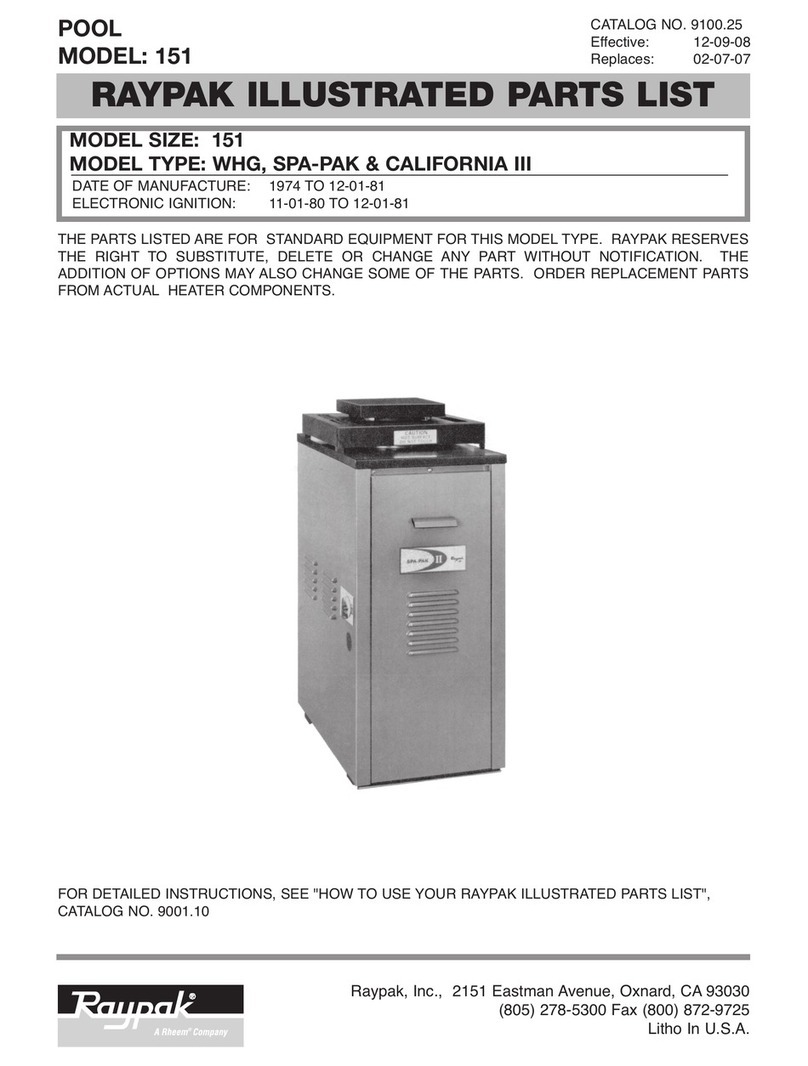
Raypak
Raypak SPA-PAK 151 Illustrate parts list
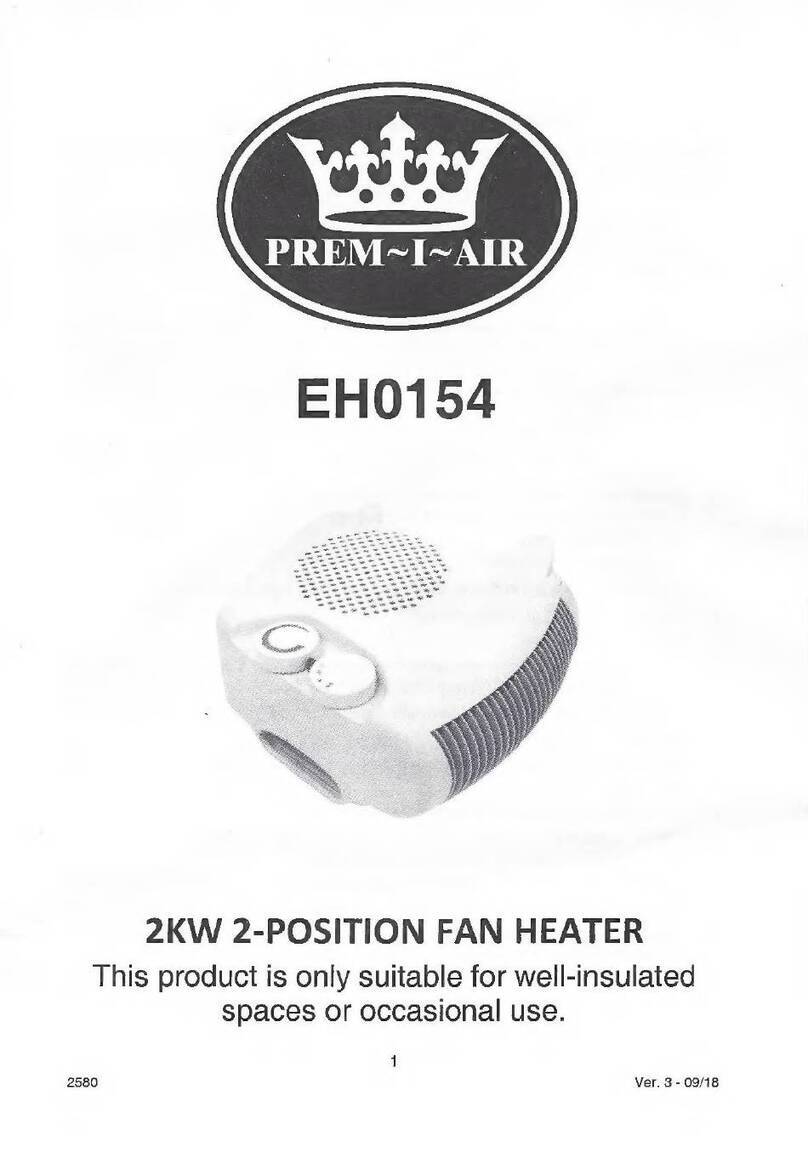
Prem-I-Air
Prem-I-Air EHO154 quick start guide

HUUM
HUUM HIVE Mini 6 Installation and operation manual
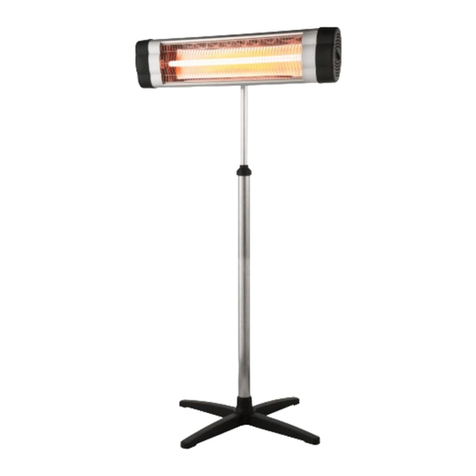
Rowi
Rowi HIT 2000/1 Q Basic Original instructions for use

Somogyi Elektronic
Somogyi Elektronic home FK 440 WIFI instruction manual

REMKO
REMKO CLK Series Operating and installation instructions

Somogyi Elektronic
Somogyi Elektronic FKC 900 instruction manual
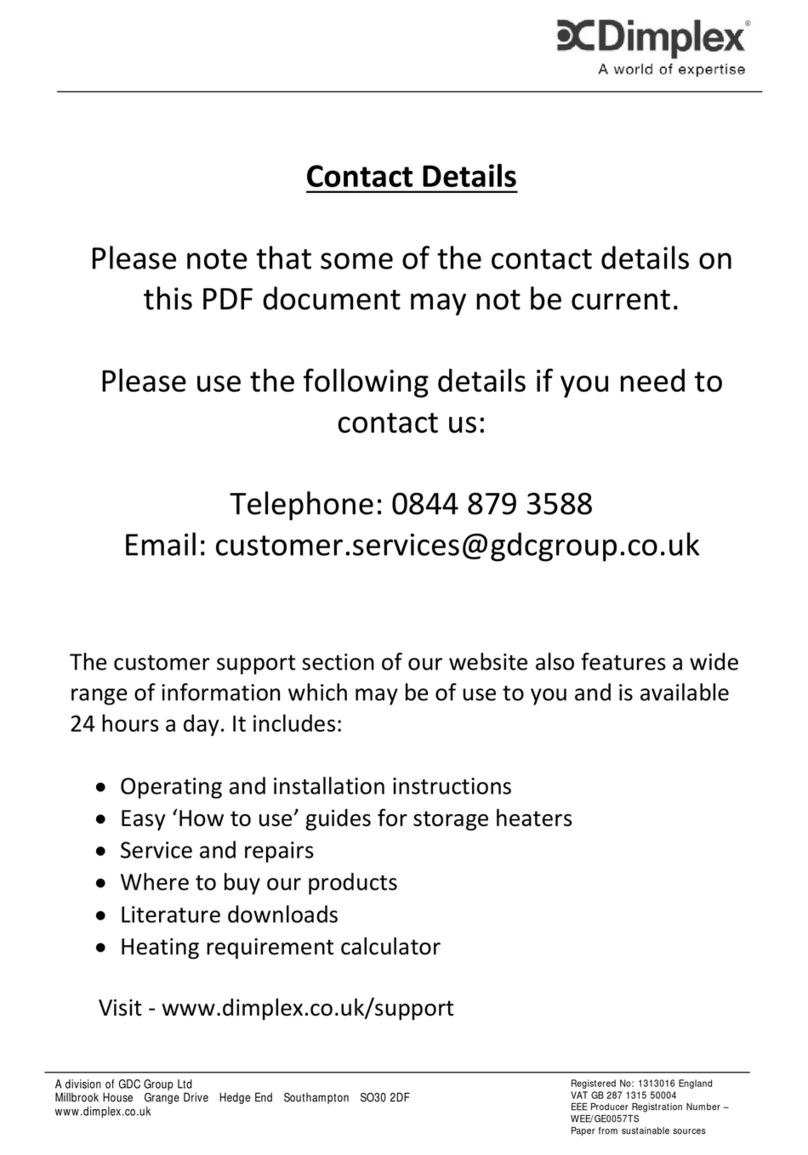
Dimplex
Dimplex DXUFSR2 Installation and operating instructions

Fanmaster
Fanmaster HDR20 instruction manual
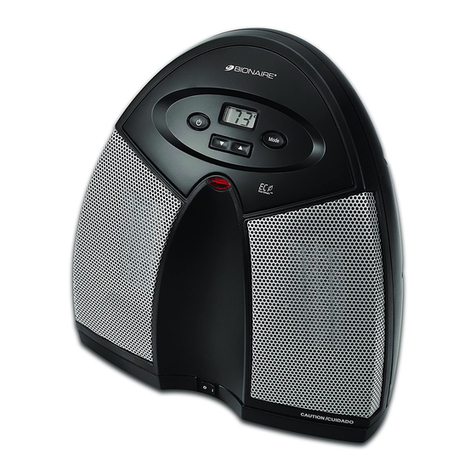
Bionaire
Bionaire BCH4175 instruction manual
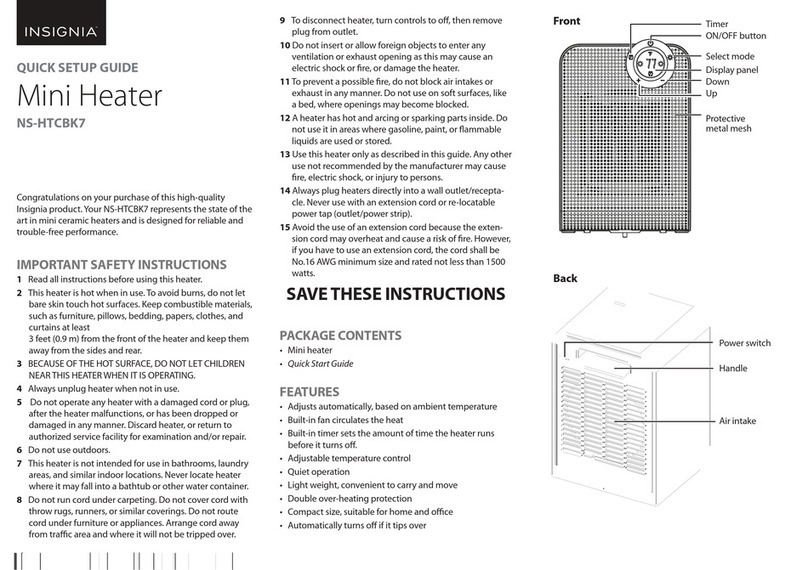
Insignia
Insignia NS-HTCBK7 Quick setup guide

